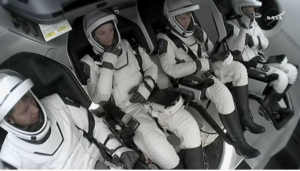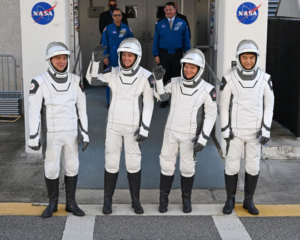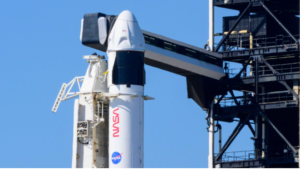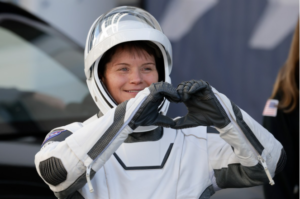Lift-off of rocket made by Elon Musk’s company will allow Butch Wilmore and Suni Williams to return from spending eight months in space on an eight-day mission
A new crew has arrived at the International Space Station on a mission that will free up four colleagues to return to Earth.
Commander Anne McClain, co-pilot Nichole Ayers and two mission specialists — Takuya Onishi of Japan and Kirill Peskov of Russia — lifted off on Friday just after 7pm local time (11pm GMT) aboard a SpaceX Crew Dragon capsule, atop a Falcon 9 rocket, from Nasa’s Kennedy Space Centre in Florida.
The craft docked with the ISS shortly after 5.45am. Live footage showed the crew embracing their counterparts after emerging from the hatch.
“Today we celebrate the countless individuals all over the world that have made this journey possible. To the engineers, instructors, flight controllers, scientists and leaders who worked tirelessly to get us here, thank you for your dedication to the safety and success of this mission,” Ayers said in a message from the capsule minutes before launch.
She added: “This mission is a testament to what humans can achieve when they work together.”

The mission has been surrounded by divisive political narrative that Nasa and the crew have sought to rise above. McClain said after the vehicle reached orbit: “Spaceflight is tough but humans are tougher. Days like today are made possible only when people choose to do the harder right, over the easier wrong.
“Build relationships, choose co-operation and believe in the inherent goodness of all people across the world … Explore boldly, live gracefully. Go Crew 10!”
It launch came two days after the original launch plan for Crew-10 was scrubbed due to a problem with a hydraulic system at the launch pad.


On Thursday SpaceX and Nasa ground teams completed inspections and “successfully flushed a suspected pocket of trapped air in the system”, Nasa said, clearing the way for Friday’s launch.
Crew-10 is expected to dock at the ISS, 260 miles above the Earth, at 7.30pm GMT on Saturday, bringing the total number of crew aboard the orbiting laboratory to 11. They will replace four of the existing crew — Butch Wilmore, Suni Williams, Nick Hague and Aleksandr Gorbunov, whose ride home has been docked at the ISS since last September.
The Crew-10 flight will be the 11th time that SpaceX has transported astronauts to the ISS for Nasa and its international partners and the 107th ISS mission overall in 25 years. More than 270 astronauts and cosmonauts have lived and worked on the station.
It is the second mission for McClain, 45, who earned her master’s degree in aerospace engineering at the University of Bath in 2004 and a masters in international relations from the University of Bristol the following year.
She is a helicopter pilot, remaining an active-duty officer in the US army, and has already spent 204 days in space.

McClain and her crewmates will spend the next six months at the orbiting laboratory conducting scientific research, including studies to assist development of new treatments for Parkinson’s disease and cancer, and testing technologies that could support future missions to the moon and Mars. Also aboard are the American astronaut Don Pettit and cosmonauts Alexey Ovchinin and Ivan Vagner.
Recalling the moment she free-floated out of the hatch at the start of her 2019 spacewalk to conduct maintenance tasks outside the ISS, McClain said: “I realised that we are operating at the edge of what humans are capable of and that is such a special moment.
“I think it’s that intersection of the magical and the technical, where I can look across the amazing beauty of the Earth but I can see also this amazing creation — the International Space Station — and it doesn’t belong to me or to Nasa. It belongs to every single human on Earth; it’s our platform to figure out how we got here, where we’re going in the future and the context in which we live.”



